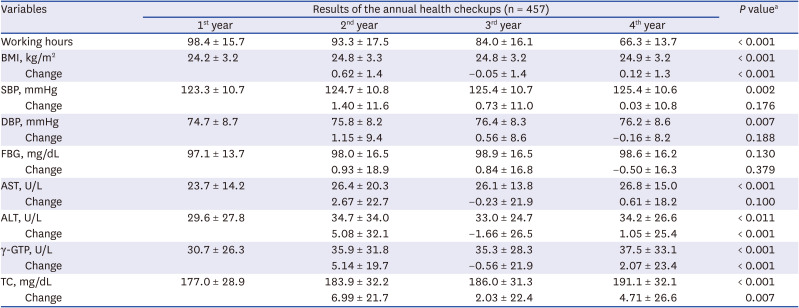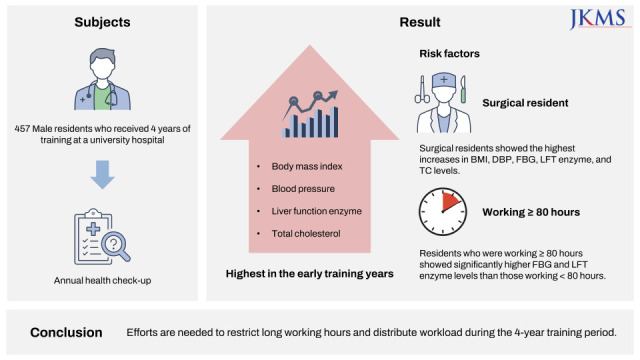1. Ebrahimi S, Kargar Z. Occupational stress among medical residents in educational hospitals. Ann Occup Environ Med. 2018; 30(1):51. PMID:
30101032.

2. Pyo J, Choi EY, Lee W, Jang SG, Park YK, Ock M, et al. Physicians’ difficulties due to patient safety incidents in Korea: a cross-sectional study. J Korean Med Sci. 2020; 35(17):e118. PMID:
32356419.

3. Kim H, Park J, Kim AR, Kim Y. Factors related to depressive symptoms in Korean self-employed workers. Ann Occup Environ Med. 2021; 33(1):e20. PMID:
34754481.

4. Lee JH, Kim SW, Joo JH, Lee NR, Lee JH, Lee KJ. Comparing risk of depression between day and night/shift workers using the PHQ-9: a study utilizing the 2014, 2016, and 2018 Korea National Health and Nutrition Examination Survey data. Ann Occup Environ Med. 2021; 33(1):e18. PMID:
34754479.

5. Choi H, Lee S, Jeon MJ, Min YS. Relationship between long work hours and self-reported sleep disorders of non-shift daytime wage workers in South Korea: data from the 5th Korean Working Conditions Survey. Ann Occup Environ Med. 2020; 32(1):e35. PMID:
34754456.

6. Eftekhari S, Alipour F, Aminian O, Saraei M. The association between job stress and metabolic syndrome among medical university staff. J Diabetes Metab Disord. 2021; 20(1):321–327. PMID:
34178840.

7. Choi EH, Kim DH, Ryu JY. The relationship between working hours and the intention to quit smoking in male office workers: data from the 7th Korean National Health and Nutrition Examination Survey (2016–2017
)
. Ann Occup Environ Med. 2021; 33:e13. PMID:
34754474.

8. Jang SW, Kim HC, Kim JH, Kim MS, Won Y, Ju H, et al. Association between nicotine dependency with occupational injury in Korean men. Ann Occup Environ Med. 2021; 33:e14. PMID:
34754475.

9. Lee J, Cho SS, Kim J, Kang MY, Ju S, Kim BG, et al. Association between sleep disturbance and occupational injury among Korean employees. Ann Occup Environ Med. 2021; 33(1):e29. PMID:
34868599.

10. Fahrenkopf AM, Sectish TC, Barger LK, Sharek PJ, Lewin D, Chiang VW, et al. Rates of medication errors among depressed and burnt out residents: prospective cohort study. BMJ. 2008; 336(7642):488–491. PMID:
18258931.

11. Virtanen M, Ferrie JE, Singh-Manoux A, Shipley MJ, Vahtera J, Marmot MG, et al. Overtime work and incident coronary heart disease: the Whitehall II prospective cohort study. Eur Heart J. 2010; 31(14):1737–1744. PMID:
20460389.

12. Akerstedt T. Psychological and psychophysiological effects of shift work. Scand J Work Environ Health. 1990; 16(Suppl 1):67–73. PMID:
2189223.

13. Harrington JM. Health effects of shift work and extended hours of work. Occup Environ Med. 2001; 58(1):68–72.

14. Baek C, Park JB, Lee K, Jung J. The association between Korean employed workers’ on-call work and health problems, injuries. Ann Occup Environ Med. 2018; 30(1):19. PMID:
29581881.

16. Kim SR, Kim SS, Kim JY. Working condition, health and perceived patient safety among doctors in training: 2014 Korean interns & residents survey. Health Soc Welf Rev. 2015; 35(2):584–607.

17. Oh SH, Kim JS, Lee PS. A survey on training and working conditions of residents in 2015. J Korean Med Assoc. 2015; 58(12):1179–1189.

18. Organisation for Economic Co-operation and Development (OECD). Average annual hours actually worked per worker. The organization for economic co-operation and development. Updated 2022. Accessed March 30, 2022.
http://stats.oecd.org/index.aspx?datasetcode=anhrs
.
19. Lee J, Kim I, Roh S. Descriptive study of claims for occupational mental disorders or suicide. Ann Occup Environ Med. 2016; 28(1):61. PMID:
27777785.

20. Kaweti G, Abegaz T. Magnitude of splash exposure and associated factors among health care workers in Hawassa referral and Adare District hospitals, January 2014. Ann Occup Environ Med. 2017; 29(1):39.

21. Ministry of Health and Welfare. Law for improving the training environment of and status of the residents. Updated 2022. Accessed March 30, 2022.
http://www.law.go.kr/
.
22. Kim YS, Park HS, Cho BS, Kim YW, Koh KW, Kang SY, et al. A study on obesity pattern and related factors of the doctors. Korean J Prev Med. 1997; 30(4):708–718.
23. Beccuti G, Pannain S. Sleep and obesity. Curr Opin Clin Nutr Metab Care. 2011; 14(4):402–412. PMID:
21659802.

24. Hall KD, Sacks G, Chandramohan D, Chow CC, Wang YC, Gortmaker SL, et al. Quantification of the effect of energy imbalance on bodyweight. Lancet. 2011; 378(9793):826–837. PMID:
21872751.

25. Amin TT, Al-Sultan AI, Ali A. Overweight and obesity and their association with dietary habits, and sociodemographic characteristics among male primary school children in Al-Hassa, Kingdom of Saudi Arabia. Indian J Community Med. 2008; 33(3):172–181. PMID:
19876479.

26. Chiang BN, Perlman LV, Epstein FH. Overweight and hypertension. A review. Circulation. 1969; 39(3):403–421. PMID:
4885946.
27. Abdullah A, Peeters A, de Courten M, Stoelwinder J. The magnitude of association between overweight and obesity and the risk of diabetes: a meta-analysis of prospective cohort studies. Diabetes Res Clin Pract. 2010; 89(3):309–319. PMID:
20493574.

28. Brown CD, Higgins M, Donato KA, Rohde FC, Garrison R, Obarzanek E, et al. Body mass index and the prevalence of hypertension and dyslipidemia. Obes Res. 2000; 8(9):605–619. PMID:
11225709.

29. Ruhl CE, Everhart JE. Determinants of the association of overweight with elevated serum alanine aminotransferase activity in the United States. Gastroenterology. 2003; 124(1):71–79. PMID:
12512031.

30. Qureshi IZ, Shabana A, Fareeha A. Effect of overweight and obesity on liver function in a sample from Pakistani population. Pakistan J. 2006; 38(1):49–54.
31. Luppino FS, de Wit LM, Bouvy PF, Stijnen T, Cuijpers P, Penninx BW, et al. Overweight, obesity, and depression: a systematic review and meta-analysis of longitudinal studies. Arch Gen Psychiatry. 2010; 67(3):220–229. PMID:
20194822.
32. Meng L, Chen D, Yang Y, Zheng Y, Hui R. Depression increases the risk of hypertension incidence: a meta-analysis of prospective cohort studies. J Hypertens. 2012; 30(5):842–851. PMID:
22343537.
33. Joules N, Williams DM, Thompson AW. Depression in resident physicians: a systematic review. Open J Depress. 2014; 3(3):89–100.
34. Lee MJ, Nho WY, Jung H, Cho JW, Seo JS, Lee HM, et al. High prevalence of depression and sleep-wake disorders among female emergency medicine residents in South Korea. Ann Med. 2022; 54(1):846–855. PMID:
35348012.

35. Kim K, Lee S, Choi YH. Relationship between occupational stress and depressive mood among interns and residents in a tertiary hospital, Seoul, Korea. Clin Exp Emerg Med. 2015; 2(2):117–122. PMID:
27752582.

36. Guille C, Frank E, Zhao Z, Kalmbach DA, Nietert PJ, Mata DA, et al. Work-family conflict and the sex difference in depression among training physicians. JAMA Intern Med. 2017; 177(12):1766–1772. PMID:
29084311.

37. Kim HJ, Kim JH, Park KD, Choi KG, Lee HW. A survey of sleep deprivation patterns and their effects on cognitive functions of residents and interns in Korea. Sleep Med. 2011; 12(4):390–396. PMID:
21388879.

38. Dawson D, Reid K. Fatigue, alcohol and performance impairment. Nature. 1997; 388(6639):235. PMID:
9230429.

39. Weinger MB, Ancoli-Israel S. Sleep deprivation and clinical performance. JAMA. 2002; 287(8):955–957. PMID:
11866625.

40. Mekonnen TH, Tefera MA, Melsew YA. Sick at work: prevalence and determinants among healthcare workers, western Ethiopia: an institution based cross-sectional study. Ann Occup Environ Med. 2018; 30(1):2. PMID:
29435337.

43. Busireddy KR, Miller JA, Ellison K, Ren V, Qayyum R, Panda M. Efficacy of interventions to reduce resident physician burnout: a systematic review. J Grad Med Educ. 2017; 9(3):294–301. PMID:
28638506.









 PDF
PDF Citation
Citation Print
Print




 XML Download
XML Download